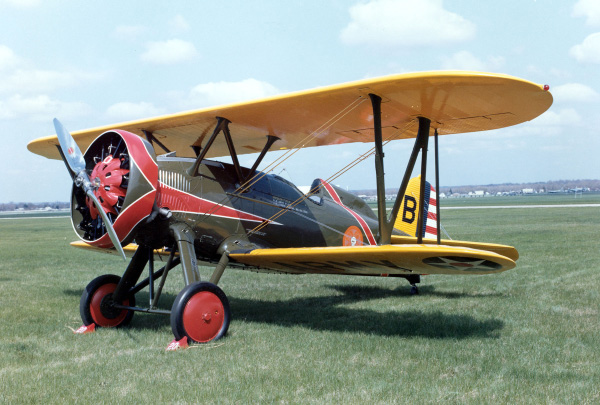
|
 |
Boeing P-12 |
 |
 |
 |
 |
 |
|---|---|---|---|---|---|---|---|
 |
 |
 |
 |
 |
|||
 |
||
|
The Boeing P-12 (Model 102) was the equivalent of the US Navy F4B-1 (Model 99). It was developed from the Model 83 and Model 89 prototypes built as a private venture to replace the United States Army Air Corps (USAAC)
PW-9s and US Navy F2Bs and F3Bs. The new aircraft was smaller, lighter and more agile and had a higher top speed and overall better performance. They were the last biplane fighters for the USAAC and became second-line fighters for the US Navy shortly after the beginning of World War II.
There was not that much difference from earlier Boeing models—it used the same Pratt & Whitney R-1340 Wasp engine as the F3B, but was an aculmination of various refinements Boeing had developed in the previous seven years of fighter design. Although biplane designs were disappearing in civil aviation, they were still in demand by the military, still following World War I fighter requirements. Experimental monoplane fighters began appearing the USAAC in 1930 and for the US Navy in 1933, but it would be another four to six years before production monoplanes would be delivered for service use. |
| The Model 83, made its inaugural flight on June 25, 1928. It employed a tapered wing constructed with two box spars with spruce flanges and 3-ply mahogany ribs. The upper wing was one piece and the lower wings were built separately and bolted together at the spar butts to become a single unit. The tail and aileron surfaces were semi-monocoque corrugated dural construction. The fuselage center was welded steel tube construction, while the aft section was bolted square dural tubing from the cockpit aft. Armament for the USAAC consisted of one .30 caliber machine gun on the left and a .50 caliber machine gun on the right. Bombs could be carried under the wings or fuselage. An auxiliary 55gallon fuel tank could be fitted under the belly as optional equipment.1 |
| Boeing supplied the USAAC with 366 P-12s between 1929 and 1932. Production of all variants totalled 586. The Model 100 was a commercial equivalent of the P-12/F4B and was produced for export. |
| Specifications: | |
|---|---|
| Boeing P-12E | |
| Dimensions: | |
| Wing span: | 30 ft 0 in (9.14 m) |
| Length: | 20 ft 4 in (6.19 m) |
| Height: | 9 ft 0 in (2.74 m) |
| Weights: | |
| Empty: | 1,664 lb (755 kg) |
| Max T/O: | 2,690 lb (1,220 kg) |
| Performance: | |
| Maximum Speed: | 189 mph (304 km/h) |
| Cruise Speed: | 160 mph (257 km/h) |
| Service Ceiling: | 26,300 ft (8,020 m) |
| Range: | 570 miles (917 km) |
| Powerplant: | |
| One 500 hp (373 kW) Pratt & Whitney R-1340-17 radial engine. | |
| Armament: | |
|
One .30 caliber and one .50 caliber machine guns plus 244 lbs. (111 kg) bombs externally. | |
Endnotes:
|
1. Peter M. Bowers. Boeing Aircraft Since 1916 New York: Funk & Wagnalls, 1968. 145. |
©Larry Dwyer. The Aviation History On-Line Museum.All rights reserved.
Created November 12, 2009. Updated October 13, 2013.